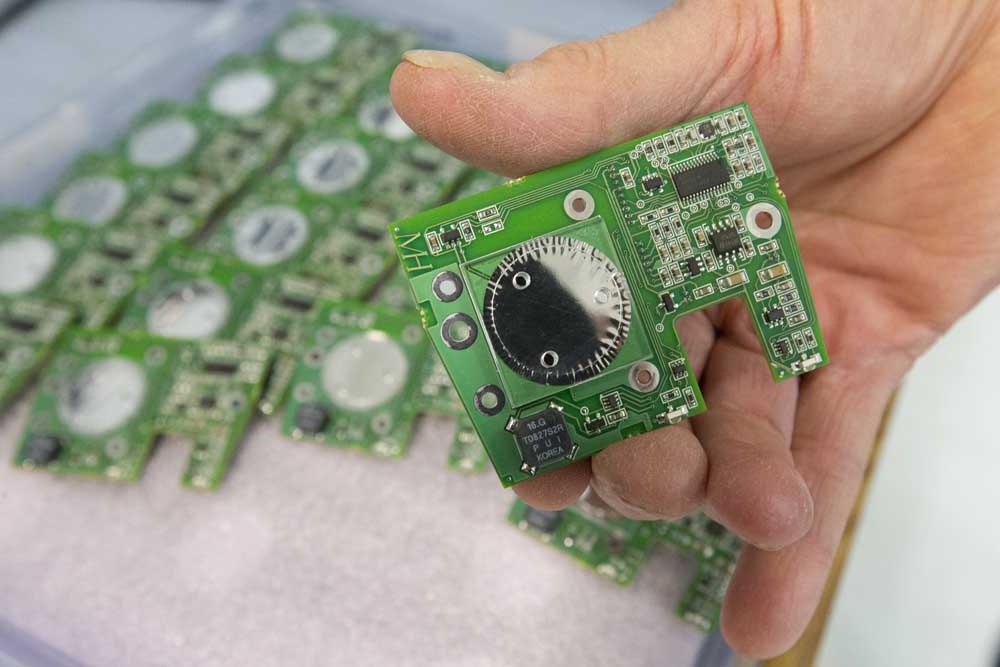Redmond firm makes oxygen systems for pioneering aviators
Published 12:00 am Thursday, February 1, 2018

- Mountain High Equipment & Supply Co. of Redmond says it’s the only company that makes an on-demand oxygen delivery system for general aviation.(Andy Tullis/Bulletin photo)
A Redmond company’s oxygen delivery system helped two Swiss pilots make it around the world in a solar-powered airplane.
Mountain High Equipment & Supply Co.’s signature technology is a controller that metes out just the right amount of oxygen for the flight altitude and only when a pilot inhales. That was probably a good thing to have when Solar Impulse II pilot Andre Borschberg made a five-day journey across the Pacific Ocean from Japan to Hawaii.
On day three of the flight, cockpit engineer Michael McGrath explained to a producer from PBS’s “Nova” that the ground crew wasn’t sure how Borschberg would perform on just a few hours of sleep for the next two days.
“We climb every day the equivalent of sea level, straight up to Mount Everest. No acclimatization,” McGrath says during “The Impossible Flight,” which aired at 9 p.m., Wednesday and is scheduled to air again at 2 a.m. Friday on PBS.
“If you don’t have enough oxygen, there’s the risk of hypoxia. Within 60 seconds, (it) will lead to a severe degradation in your ability to understand what’s going on around you,” McGrath says. “You become euphoric so not only are you in a dangerous situation, you’re not able to recognize the situation and you feel good about not recognizing the situation. Then very quickly you will pass out.”
Borschberg ended up setting a new solo flight record when he landed in Hawaii in 2015. Pilot Bertrand Piccard completed the circumnavigation in 2016. It’s been several years since Mountain High first sold equipment to the Solar Impulse project, and as far as General Manager Brad Stankey knows, it all worked as expected.
“Their Houston doesn’t necessarily share that with us,” he said.
Representatives of the Solar Impulse II team weren’t available for comment.
Anyone who watches the 120-minute Nova special will see the pilots wearing Mountain High’s blue face mask, but it doesn’t mention the company or explain how its Pulse Demand controller works.
Most aviation oxygen systems supply a constant flow, but that requires too much weight, and pilots on long flights could run out of oxygen if they let it flow constantly, Stankey said. Mountain High’s Pulse Demand controller contains a barometric sensor that allows it to supply the right amount of oxygen for the altitude, he said. It’s the same basic technology that company founder Patrick McLaughlin, an engineer and glider pilot, came up with in 1985, though the circuitry has been refined over the years.
The Solar Impulse II carried six 115-cubic-foot cylinders of oxygen, which is enough for 198 hours of flight at 25,000 feet, Stankey said. Although the pilots flew up to almost 30,000 feet during the day to charge the plane’s solar-powered batteries, they descended to about 1,000 feet at night, which means they would not have needed oxygen around the clock, he said.
In the United States, pilots who fly above 12,000 feet in unpressurized aircraft are required to have oxygen, but oxygen is also used at lower altitudes and on board pressurized cabins in case of emergencies. McLaughlin estimates that Mountain High has shipped more than 25,000 Pulse Demand systems to users around the world.
Glider and general aviation pilots are the bulk of the customer base, Stankey said. In recent years the company has also supplied thousands of units to the U.S. Army for helicopter pilots and crew members. Hypoxia was leading to canceled missions in the high mountains of Afghanistan, he said.
McLaughlin moved the company to Redmond in 2000. It employs 15 people, who do all the engineering and assembly there. The small company has developed a reputation for special projects. Mountain High supplied the Voyager experimental aircraft’s nonstop around-the-world flight in 1986. Currently, Mountain High is working with the Perlan project, which is trying to send a glider to the edge of space, Stankey said.
“We were the only game in town addressing life support for the pilot,” McLaughlin said.
—Reporter: 541-617-7860, kmclaughlin@bendbulletin.com







